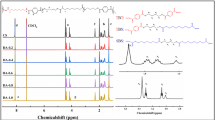Abstract
Poly (dihydroferulic acid) (PHFA) from biorenewable vanillin was reported before as an alternative replacement of polyethylene terephthalate (PET). Thermal properties of PHFA were found to be very close to those of commercial polyethylene terephthalate (PET). However, PHFA was insoluble in common organic solvents, and it was difficult to measure molecular weight of the obtained polymer due to difficulty of performing gel permeation chromatography (GPC) analysis. In order to modulate the physical properties of PHFA, here we report a new kind of polyester synthesized from ethyl vanillin instead of vanillin as a starting material. Ethyl group on the monomer was found to disrupt the crystallinity, improve the thermal properties and increase the solubility of the obtained polymer. 3-(4-acetoxy)-3-ethoxyphenyl) propanoic acid (AEPPA) was obtained from the reaction between ethyl vanillin and acetic anhydride through Perkin reaction and subsequent hydrogenation. Polycondensation of AEPPA was achieved using zinc acetate catalyst and resulted in poly (3-(4-acetoxy)-3-ethoxyphenyl) propanoic acid) with 75% yield and high solubility in common organic solvents. Thermal transition temperatures of the obtained polymer are very close to those of commercial PET. Polycondensation was further extended to copolymerization of AEPPA and monomers derived from vanillin and syringaldehyde. Synthesized copolymers also showed higher solubility and tunable thermal properties compared to the PHFA from vanillin.





Similar content being viewed by others
References
East AJ (2006) Polyesters, Thermoplastics. In: Seidel A, Bickford M (eds) Kirk-Othmer Encyclopedia of Chemical Technology, vol 20, 2nd edn. John Wiley & Sons, New York, pp 31–95
Qi P, Chen H-L, Nguyen HTH, Lin C-C, Miller SA (2016) Synthesis of biorenewable and water-degradable polylactam esters from itaconic acid. Green Chem 18:4170–4175. https://doi.org/10.1039/C6GC01081D
Gandini A (2011) Monomers and Macromonomers from Renewable Resources. In: Loos K (ed) Biocatalysis in Polymer Chemistry, Wiley-VCH Verlag GmbH & Co. KGaA, Weinheim, pp 1-33. Doi: 10.1002/9783527632534.ch1
Chen GQ, Patel MK (2012) Plastics Derived from Biological Sources: Present and Future: A Technical and Environmental Review. Chem Rev 112(4):2082–2099. https://doi.org/10.1021/cr200162d
Nsengiyumva O, Miller SA (2019) Synthesis, characterization, and water-degradation of biorenewable polyesters derived from natural camphoric acid. Green Chem 21:973–978. https://doi.org/10.1039/C8GC03990A
Nguyen HTH, Qi P, Rostagno M, Feteha A, Miller SA (2018) The quest for high glass transition temperature Bioplastics. J Mater Chem A 6:9298–9331. https://doi.org/10.1039/C8TA00377G
Reyhanoglu Y, Sahmetlioglu E, Gokturk E (2019) Alternative approach for synthesizing polyglycolic acid copolymers from C1 feedstocks and fatty ester epoxides. ACS Sustainable Chem Eng 7:5103–5110. https://doi.org/10.1021/acssuschemeng.8b05940
Bosetti C, La Vecchia C, Lipworth L, McLaughlin JK (2003) Occupational exposure to vinyl chloride and cancer risk: a review of the epidemiologic literature. Eur J Cancer Prev 12(5):427–430. https://doi.org/10.1097/01.cej.0000090184.08740.10
Myer Kutz M (2012) Handbook of environmental degradation of materials. 2nd edn. William Andrew Publishing. Doi: 10.1016/C2010-0-66227-4
Thornton J (2002) Environmental Impacts of Polyvinyl Chloride Building Materials, Washington. https://s3.amazonaws.com/hbnweb.dev/uploads/files/environmental-impacts-of-polyvinyl-chloride-building-materials.pdf. Accessed 11 June 2020.
Mialon L (2010) Synthesis of New Aromatic Polyesters from a Biorenewable Feedstock: Lignin. University of Florida PhD Thesis. https://ufdc.ufl.edu/UFE0041414/00001
Diot-Neant F, Rastoder E, Miller SA, Allais F (2018) Chemo-Enzymatic Synthesis and Free Radical Polymerization of Renewable Acrylate Monomers from Cellulose-Based Lactones. ACS Sustainable Chem Eng 6:17284–17293. https://doi.org/10.1021/acssuschemeng.8b04707
Rostagno M, Price EJ, Pemba AG, Ghiriviga I, Abboud KA, Miller SA (2016) Sustainable polyacetals from erythritol and bioaromatics. J Appl Polym Sci. https://doi.org/10.1002/APP.44089
Reyhanoglu Y, Gokturk E (2019a) Polyglycolic acid copolymers from one-step cationic polymerization of formaldehyde, carbon monoxide, and epoxides derived from PEG. Polym Adv Technol 30:1789–1795. https://doi.org/10.1002/pat.4611
Reyhanoglu Y, Gokturk E (2019b) Synthesis of polyglycolic acid copolymers from cationic copolymerization of C1 feedstocks and long chain epoxides. J Saudi Chem Soc 23:879–886. https://doi.org/10.1016/j.jscs.2019.01.008
Short GN, Nguyen HTH, Scheurle PI, Miller SA (2018) Aromatic polyesters from biosuccinic acid. Polym Chem 9:4113–4119. https://doi.org/10.1039/C8PY00862K
Thiele UK (2010) Future scenario in polyester fiber and filament production. Chem Fibers Int 60:46–48
Mialon L, Pemba AG, Miller SA (2010) Biorenewable polyethylene terephthalate mimics derived from lignin and acetic acid. Green Chem 12:1704–1706. https://doi.org/10.1039/C0GC00150C
Mialon L, Vanderhenst R, Pemba AG, Miller SA (2011) Polyalkylenehydroxybenzoates (PAHBs): Biorenewable Aromatic/Aliphatic Polyesters from Lignin. Macromol Rapid Commun 32:1386–1392. https://doi.org/10.1002/marc.201100242
Rule M (2005) Physical Constants of Poly(oxyethyleneoxyterephthaloyl), (Poly(ethylene terephthalate)). In: Brandrup J, Immergut EH, Grulke EA, Abe A, Bloch DR (ed) Polymer Handbook, 8 4th Edn. John Wiley & Sons, New York, pp V/113-V/118.
Diez-Pascual AM, Gomez-Fatou MA, Ania F, Flores A (2015) Nanoindentation in polymer nanocomposites. Prog Mater Sci 67:1–94. https://doi.org/10.1016/j.pmatsci.2014.06.002
Zhang Z, Zhang Y, Zhang J, Zhu Y (2019) Structure, mechanics and material properties of claw cuticle from mole cricket Gryllotalpaorientalis. PLoS ONE 14(9):e0222116. https://doi.org/10.1371/journal.pone.0222116
Tozar A, Karahan İH (2018a) A comparative study on the effect of collagen and h-BN reinforcement of hydroxyapatite/chitosan biocomposite coatings electrophoretically deposited on Ti-6Al-4V biomedical implants. Surf Coat Technol 340:167–176. https://doi.org/10.1016/j.surfcoat.2018.02.034
Tozar A, Karahan İH (2018b) A comprehensive study on electrophoretic deposition of a novel type of collagen and hexagonal boron nitride reinforced hydroxyapatite/chitosan biocomposite coating. Appl Surf Sci 452:322–336. https://doi.org/10.1016/j.apsusc.2018.04.241
Cho D-H, Bhushan B (2016) Nanofriction and nanowear of polypropylene, polyethylene terephthalate, and high-density polyethylene during sliding. Wear 352–353:18–23. https://doi.org/10.1016/j.wear.2016.01.018
Acknowledgments
Gulsah Kurt would like to thank to the Council of Higher Education in Turkey for her visiting professorship. Authors would also like to thank Prof. Dr. Stephen A. Miller for his guidance and help during the study.
Author information
Authors and Affiliations
Corresponding author
Additional information
Publisher's Note
Springer Nature remains neutral with regard to jurisdictional claims in published maps and institutional affiliations.
Electronic supplementary material
Below is the link to the electronic supplementary material.
Rights and permissions
About this article
Cite this article
Kurt, G., Gokturk, E. Synthesis of polyesters mimicking polyethylene terephthalate and their thermal and mechanical properties. J Polym Res 27, 314 (2020). https://doi.org/10.1007/s10965-020-02285-0
Received:
Accepted:
Published:
DOI: https://doi.org/10.1007/s10965-020-02285-0




